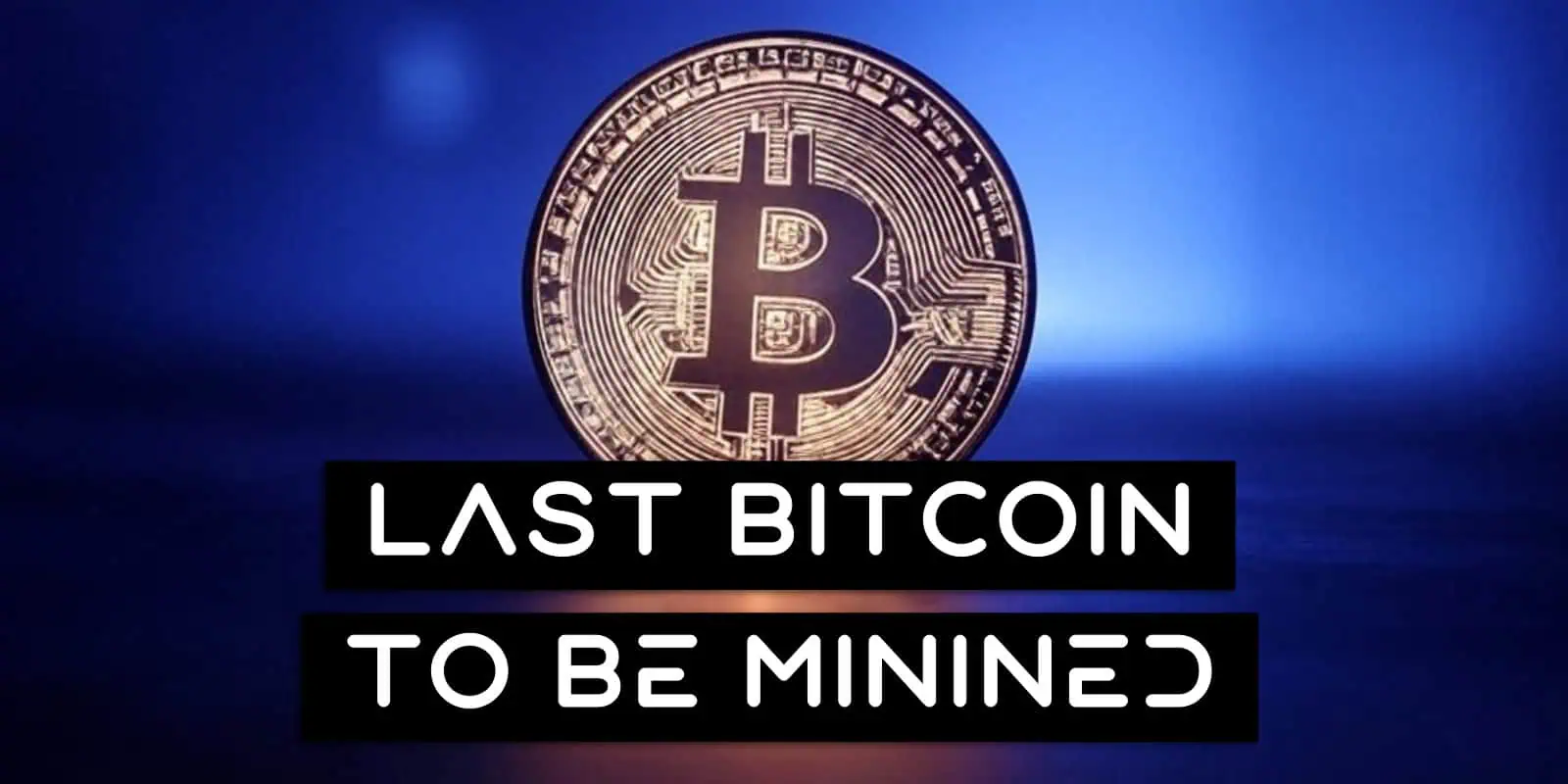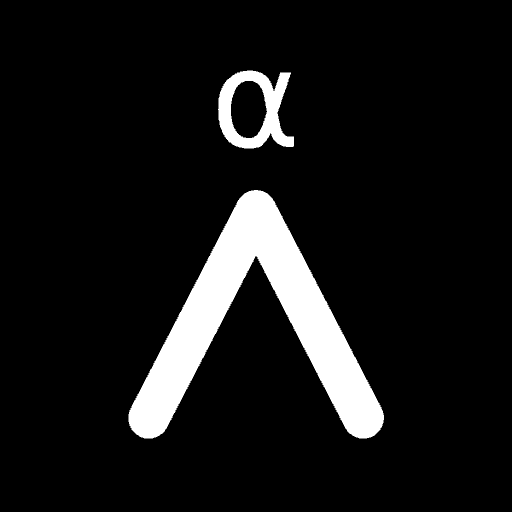Ever thought, when will the last Bitcoin be mined? The short answer is around 2140, but we’re going to explain why and also explore a bit more than that below. As the world of cryptocurrency continues to evolve, this question has become a hot topic among investors and enthusiasts alike. With only 21 million coins in circulation, the countdown to the final Bitcoin is as intriguing as it is inevitable.
Contents
Bitcoin Basics
Bitcoin is the first and most globally recognized cryptocurrency. That means it’s a currency backed by maths and cryptography, rather than by a single country or government.
It’s free for anyone in the entire world to own and you can use it by sending or receiving it with other people just like any other money. Unlike fiat money though, it cannot be stopped or censored and its rules cannot be changed, no matter how rich or powerful a country or person is. In short, a select few powerful elites can’t control it because no one controls it.
>> Deeper Dive: 4 Breakthrough Characteristics Of Bitcoin & Why It Has Value
What Is The Total Supply Of Bitcoin?
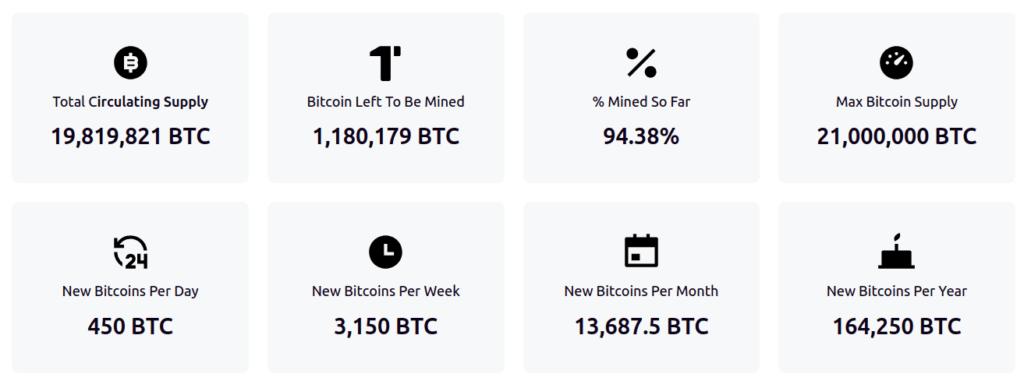
- Total Supply: 21,000,000 bitcoin
- Total Circulating Supply: Around 19.8M bitcoin
- Percentage Of Mined Bitcoin: 94.4%
- Bitcoin Mined: 450 bitcoin are mined each day, 3,150 bitcoin each week and 13,687.5 bitcoin each month
One of the biggest reasons Bitcoin is the best Store Of Value is that it’s the only one that has provable, finite scarcity. There will never be more than 21 million bitcoin or 21 quadrillion Satoshi. This is because it’s written into the Bitcoin Core code and will never be changed (we’ll get into why that is below).
There are currently around 19,820,000 bitcoin that have been mined already, but for the most up to date, live figure click here: How Many Bitcoins Are There?
How Is Bitcoin Distributed?
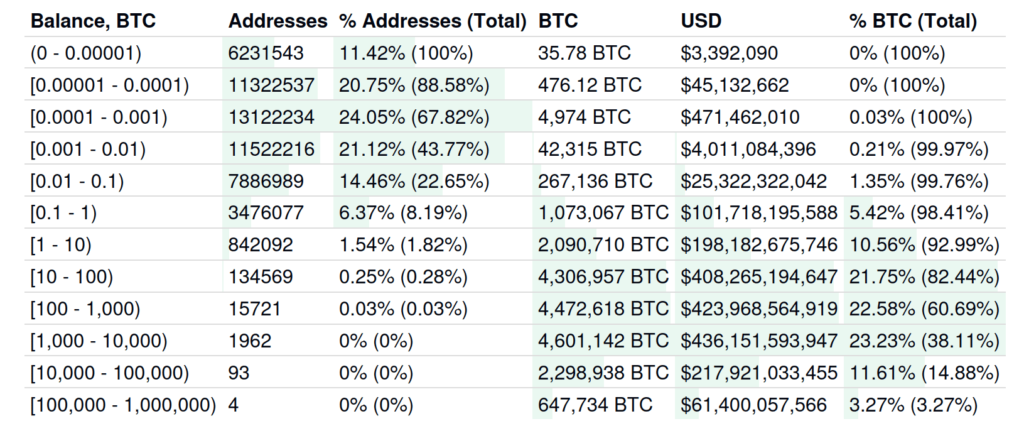
With no central authority, Bitcoin somehow needs a way to mint and distribute the 21 million bitcoins. To do this, Satoshi decided that in order to receive these newly minted bitcoins a person had to prove that they have fairly worked for them.
This work, as explained above, had to use a real world, physically limiting thing as otherwise they could just copy/paste the work a billion times and be rich with zero effort. PoW and the mining process is what provides this “proof” to the network and as a result, miners that solve a block get both the block reward and all the fees in each of the transactions that they’ve mined.
An important distinction should also be noted at this time. Miners do not “create” new bitcoins. They create or produce new blocks. If this new block meets the rules of the Bitcoin network and is accepted and validated by all the other nodes on the network, then they will be rewarded with the block reward.
The block reward is currently 3.125 BTC. Originally it used to be 50 BTC but over the years it has been cut in half a number of times in what’s called the “Bitcoin Halving” or halvening. This lets the network mint and distribute new bitcoins while giving a higher reward to those that adopt the network (and do mining) first. A very fair process!
>> Dive Deeper: Bitcoin Halving
These happens every 210,000 blocks which is roughly around every 4 years. Since the genesis block there have been 4 halvings (28th Nov 2012, 9th Jul 2016, 11th May 2020 and 20th April, 2024) and when the next one occurs in 2028, this 3.125 BTC block reward will be halved once again down to 1.5625 BTC further slowing the issuance of new bitcoins.
Written into the core of the Bitcoin software is a hard coded limit of 21 million bitcoins. This means that even in a million years time, there will still only ever be 21 million coins. Given the predictable issuance of new coins and the reduction of block rewards, all 21 million of them will be mined by 2140.
Another important point to note is that increasing the amount of computing power dedicated to mining bitcoin doesn’t mean more bitcoins will be mined. If you add more miners with more computing power it just increases their chance of being rewarded in the next block. Each block will still only mint 3.125 bitcoin, and those blocks will still only be created on average every 10 minutes.
Bitcoin Mining & The Bitcoin Network
To dive deeper into when the last bitcoin will be mined, we have to understand a bit more about the Bitcoin network and the miners that are a part of that network.
What Is Bitcoin Mining Process?
Mining is the process of adding transactions to the Bitcoin Blockchain.
Proof-of-Work (PoW) mining also performs two other critical functions in the Bitcoin network:
- Secures the network from attackers
- Issues / mints new bitcoins in a fair, automatic and distributed way
While many think the idea of having a digital currency was the “breakthrough”, it’s arguably more the PoW, mining and difficulty adjustment ideas that combined to be the true utter genius invention.
Before Bitcoin there were a slew of digital, cryptographic based currency attempts that all failed. It wasn’t until the mining process, PoW and the difficulty adjustment mechanism was fully fleshed out and laid bare by Satoshi that the digital cryptocurrency industry was truly born.
How Does The Bitcoin Mining Process Work?
In our Bitcoin network we have many nodes. Each node is capable of mining and contains both the mempool (shown with green transactions) as well as a full copy of the Bitcoin blockchain (with the blue blocks). The Mempool is just all the most recent transactions that haven’t yet been confirmed into the blockchain.
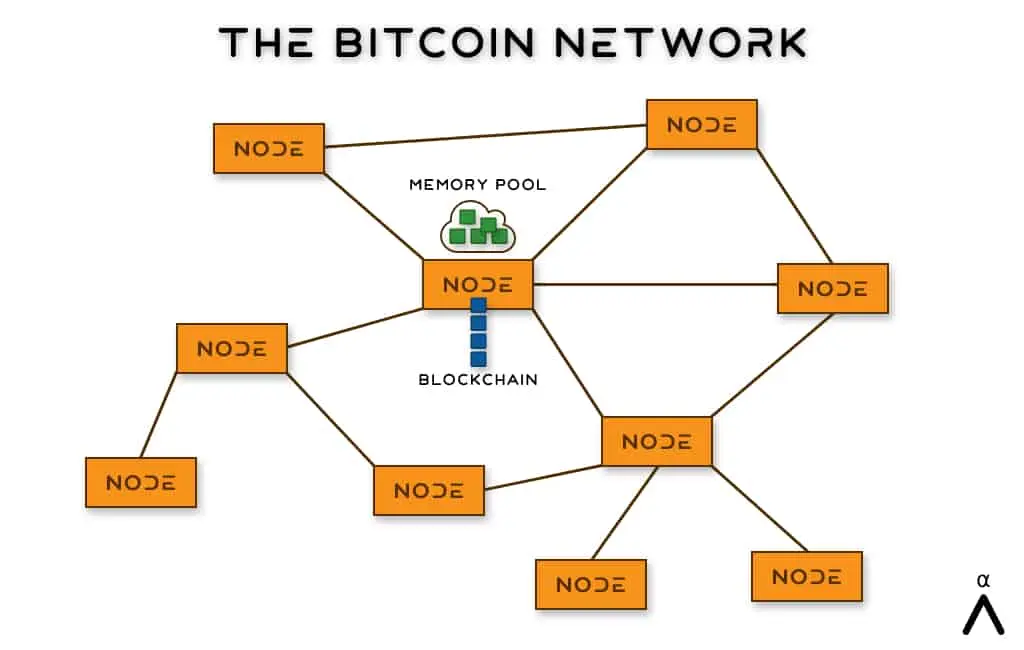
Mining takes those transactions in the mempool, bundles them together and confirms them into the blockchain.
To perform this mining process though, a miner needs to expend a lot of computer processing power or “work”. This work takes the form of a challenge.
The first step of this challenge is to take all the transactions in your memory pool and hash them. This gives you a big long random string like so.
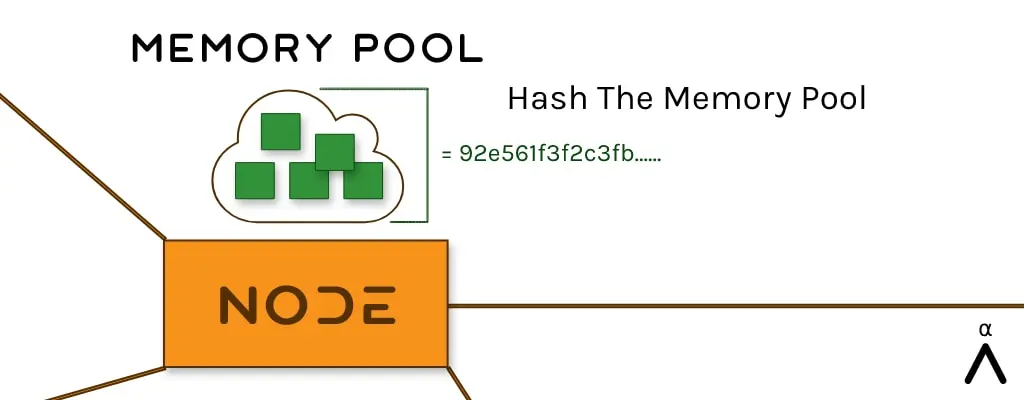
Now to win the challenge, you have to hash that string with another random number of your choosing (called a nonce) and try to get a new string that begins with a bunch of zeros.
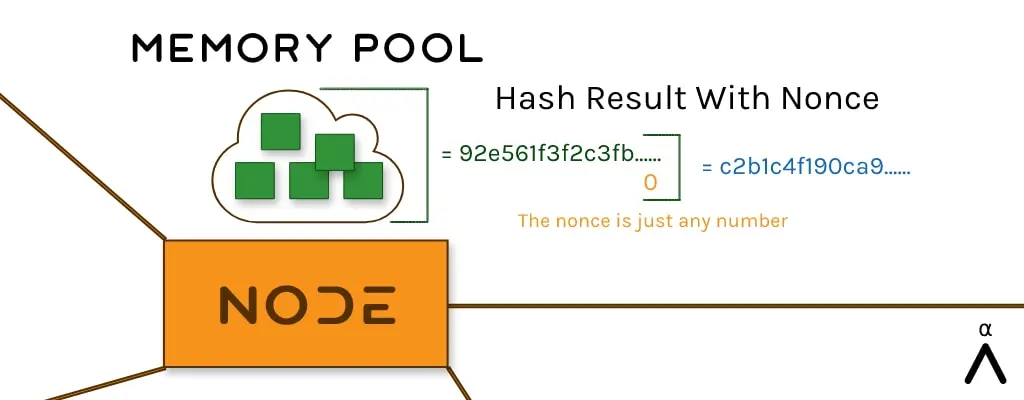
This is extremely difficult to do as the hashing process is essentially random. The only way you can win the challenge is through sheer brute force. Performing this same hashing process (Step 2) over and over and over again until…
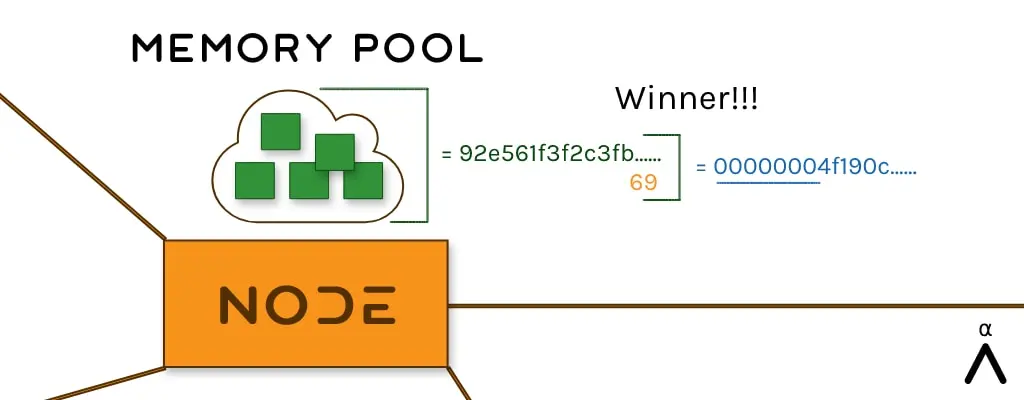
You win! Eventually with enough time and enough hashes, you’ll stumble onto a nonce that, together with the original string, hashes together to give you a result that has a bunch of zeros at the front. The number of zeros is determined by the adjustment difficulty factor (explained below).
At this point you have “solved” the block and all of the transactions inside are added onto the blockchain. You also broadcast this new block to every other node on the network which adds it to their blockchain assuming everything checks out and is valid.
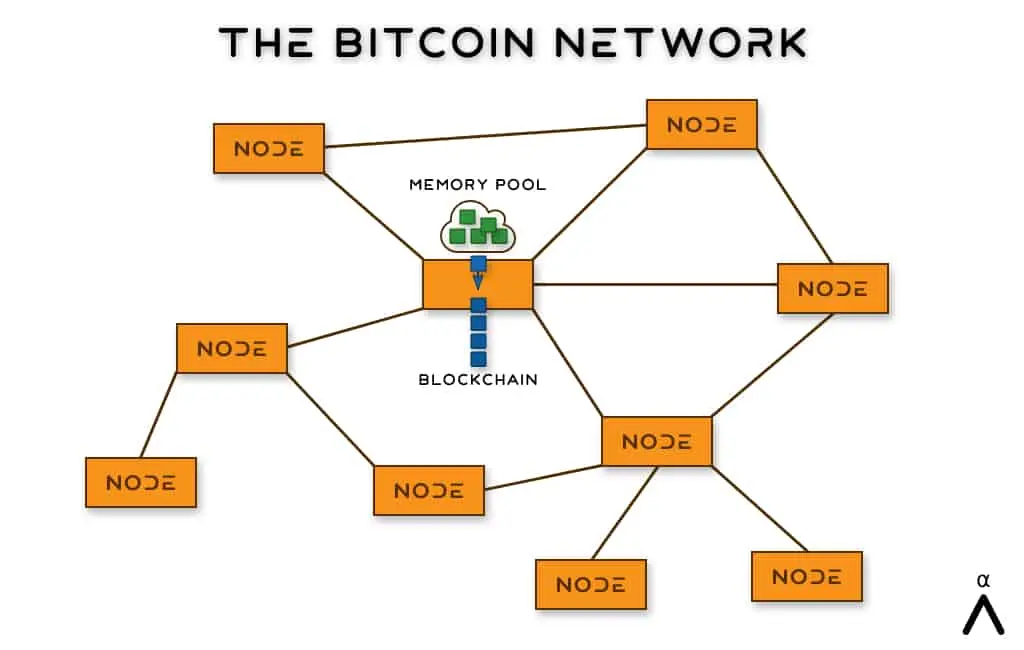
If you’re the first miner to win this challenge and broadcast your valid block to every other node you not only get to keep all the fees paid by all the transactions in that block, but a generous 3.125 BTC (the block reward) on top of that too! Yes, step 3 really is profit this time!
>> Much Deeper Dive: What Is Bitcoin Mining?
What Is The Bitcoin Halving?
The Bitcoin Halving is when the block subsidy that’s rewarded to Bitcoin miners is halved. Currently the block subsidy is 3.125 BTC, but after the next halving it will reduce to 1.5625 BTC.
Note: The existing circulating supply of all bitcoins remains the same before and after each halving. It’s only the rate at which new bitcoins are minted that is halved.
The day of a Bitcoin halving is tracked and celebrated around the world by millions of Bitcoin users as it represents an event that only occurs once every 4 years. There have been four halving days so far, each one occurring after 210,000 blocks have been mined and this tradition will continue according to the bitcoin halving schedule below.
This type of fixed and dependable monetary policy is quite different to how traditional fiat currencies operate as they’re instead tied to central banks that dictate how their currency is distributed (aka printed). This also means it’s constantly changing and controlled entirely by a select few, who usually aren’t even democratically elected.
Why Halving Dates Are Approximate
Although we humans measure time with calendar days, dates and years, Bitcoin is a bit different. It measures time in blocks. One block is mined roughly every 10 minutes on average and so 210,000 blocks is about 4 years.
210,000 Blocks * 10 Minutes = 2,100,000 Minutes = 35,000 Hours = 3.9927 Years
While one block is mined on average every 10 minutes, it’s not always exactly every 10 minutes. As the process to find a valid block includes randomness, blocks are found at random times. As you can see below in this selection of mined blocks, the first block was mined after 6 minutes, the second after 16 minutes and so on. On average though, you get one block every 10 minutes.
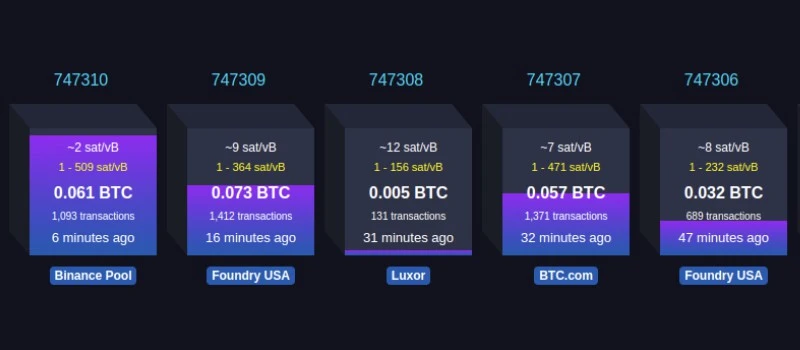
This means that the next BTC halving date isn’t known until it happens. When block 1,050,000 is mined we’ll have the exact time and date for the 2028 Bitcoin halving, but until then we can only give a rough estimate on future halving dates.
>> Learn More: Bitcoin Halving Countdown
How Is The 21 Million Bitcoin Supply Limit Enforced?
Interestingly, there is no actual “21 million supply limit” in the Bitcoin Core code, that’s just not how bitcoin operates. Instead, the total supply of bitcoin is limited to just under 21 million bitcoins by just 6 lines of code shown below that calculates the block subsidy. This Bitcoin Core code is located in the “validation.cpp” file under bitcoin/src/.
What it does is figure out how many Bitcoin Halving events have happened, then calculates the size of the block subsidy that’s given to bitcoin miners for that block. Currently there have been 3 halvings and the block subsidy is 3.125 BTC. Due to this specific code, there will only ever be a total of 33 halvings.
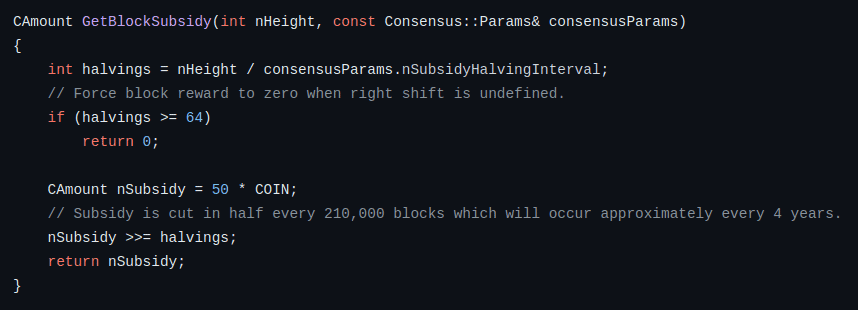
We can also easily use it to calculate the exact amount of bitcoin mined every day, for the rest of all time. As a result, the total bitcoin supply is simply the sum of all these mined bitcoins. The only way to increase the number of bitcoins would be to change this code, which would be fiercely opposed by virtually all bitcoin holders.
When Will The Last Bitcoin Be Mined?
Below are all the historic and future Bitcoin halving dates. As you can see, they occur every 210,000 blocks and will continue until around 2140 which will be the last Bitcoin halving. After this, the Block Subsidy will be reduced to 0, the last bitcoin will have finally been mined and the Block Reward will be entirely made up of just transaction fees.
| Halving | Era | Block Height | Block Subsidy | Date |
|---|---|---|---|---|
| 2009 | 0 (Genesis Block) | 50.00000000 BTC | 3rd Jan, 2009 | |
| 1 | 2012 | 210,000 | 25.00000000 BTC | 28th Nov, 2012 |
| 2 | 2016 | 420,000 | 12.50000000 BTC | 9th Jul, 2016 |
| 3 | 2020 | 630,000 | 6.25000000 BTC | 11th May, 2020 |
| 4 | 2024 | 840,000 | 3.12500000 BTC | 20th Apr, 2024 |
| 5 | 2028 (est) | 1,050,000 | 1.56250000 BTC | |
| 6 | 2032 (est) | 1,260,000 | 0.78125000 BTC | |
| 7 | 2036 (est) | 1,470,000 | 0.39062500 BTC | |
| 8 | 2040 (est) | 1,680,000 | 0.19531250 BTC | |
| 9 | 2044 (est) | 1,890,000 | 0.09765625 BTC | |
| 10 | 2048 (est) | 2,100,000 | 0.04882813 BTC | |
| 11 | 2052 (est) | 2,310,000 | 0.02441406 BTC | |
| 12 | 2056 (est) | 2,520,000 | 0.01220703 BTC | |
| 13 | 2060 (est) | 2,730,000 | 0.00610352 BTC | |
| 14 | 2064 (est) | 2,940,000 | 0.00305176 BTC | |
| 15 | 2068 (est) | 3,150,000 | 0.00152588 BTC | |
| 16 | 2072 (est) | 3,360,000 | 0.00076294 BTC | |
| 17 | 2076 (est) | 3,570,000 | 0.00038147 BTC | |
| 18 | 2080 (est) | 3,780,000 | 0.00019073 BTC | |
| 19 | 2084 (est) | 3,990,000 | 0.00009537 BTC | |
| 20 | 2088 (est) | 4,200,000 | 0.00004768 BTC | |
| 21 | 2092 (est) | 4,410,000 | 0.00002384 BTC | |
| 22 | 2096 (est) | 4,620,000 | 0.00001192 BTC | |
| 23 | 2100 (est) | 4,830,000 | 0.00000596 BTC | |
| 24 | 2104 (est) | 5,040,000 | 0.00000298 BTC | |
| 25 | 2108 (est) | 5,250,000 | 0.00000149 BTC | |
| 26 | 2112 (est) | 5,460,000 | 0.00000075 BTC | |
| 27 | 2116 (est) | 5,670,000 | 0.00000037 BTC | |
| 28 | 2120 (est) | 5,880,000 | 0.00000019 BTC | |
| 29 | 2124 (est) | 6,090,000 | 0.00000009 BTC | |
| 30 | 2128 (est) | 6,300,000 | 0.00000005 BTC | |
| 31 | 2132 (est) | 6,510,000 | 0.00000002 BTC | |
| 32 | 2136 (est) | 6,720,000 | 0.00000001 BTC | |
| 33 | 2140 onward | 6,930,000 onward | 0.00000000 BTC |
What Will Happen When All 21 Million Bitcoins Are Mined?
The Block Reward is paid out to bitcoin miners that successfully add new, valid bitcoin blocks to the Bitcoin Blockchain and is made up of two parts:
Block Reward = Block Subsidy + Transaction Fees.
The Block Subsidy is freshly minted bitcoins that are added to the network as part of the block reward for bitcoin miners doing Proof-of-Work (PoW). The transaction fees are just what people are paying to have their transactions included in the block and are already existing bitcoins.
When Bitcoin first started, the Block Subsidy was 50 BTC. Each time someone mined a new block, they would get all the transaction fees and the ability to spend 50 new bitcoins. As you can see, this is a huge incentive and a much bigger block reward than what bitcoin miners get now, which is only 3.125 BTC.
While it’s true that once the limited supply of bitcoin is reached miners won’t receive any more block subsidies, this is far off into the future. It’s also estimated that the transaction processing fees will have long taken over as the main source of mining rewards before this 2140 date is reached.
The bitcoin mining industry is already getting more and more of the mining reward from bitcoin transaction fees and this is seen as a healthy thing for the bitcoin ecosystem in general. As the number of bitcoins created decreases, it’s also likely that it will increase bitcoin’s price too. This will mean that these relatively smaller fees will become more and more valuable over time.
Can Bitcoin’s Supply Cap Be Changed?
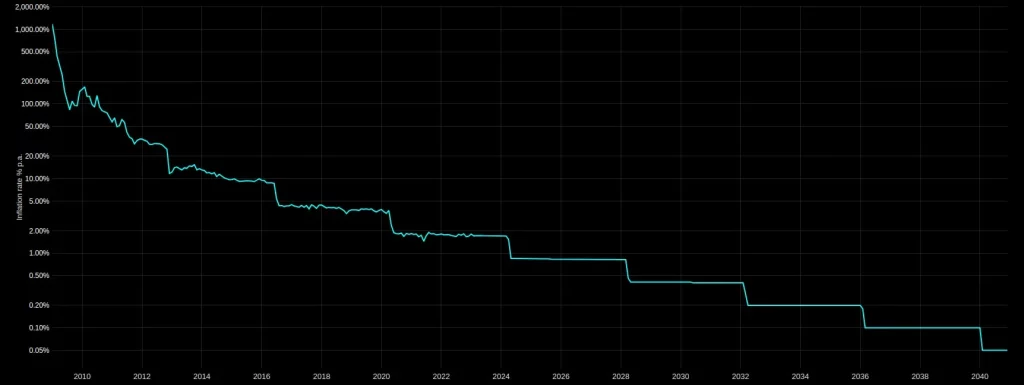
The short answer is no.
While anyone is free to copy and change the Bitcoin Core code, it would only be considered “the real Bitcoin” if the hundreds of thousands of full Bitcoin Nodes and Bitcoin Miners made the conscious decision to manually update their software to it.
A great way to explain this is with Chess. Imagine that you didn’t like the rules of chess for some reason, so you created a new Chess 2.0. Chess has been played with the same basic rules for thousands of years all over the world. You’re free to create Chess 2.0, but it’s not going to change how everyone else plays the game.
Similarly, anyone is free to change the Bitcoin Core code to have any maximum supply they want. But there would be no reason for anyone to use this new code as it would dilute the value of their bitcoin holdings and they’re happy using the current Bitcoin network.
To truly change Bitcoin’s total supply, a Hard Fork update to Bitcoin Core would need to be manually and consciously installed on the overwhelming majority of the hundreds of thousands of privately owned Bitcoin nodes all around the world. As you can imagine, this is never going to happen.
This is a critical fact for all bitcoin investors to understand and internalize, as although bitcoin evolves, its supply cap will never change.
Who Owns The Most Bitcoins?
Getting straight to the point, the largest bitcoin owners are made up of both individuals as well as other entities such as private companies, publicly traded companies, governments, ETFs and more. As a rough overview the amounts they own are as follows:
- Individuals: 14.69M BTC
- ETF’s/Funds: 1.25M BTC
- Satoshi Nakamoto: 968,452 BTC
- Companies: 811,000 BTC
- Governments: 529,618 BTC
There’s also around 1.18M BTC that are still yet to be mined.
Other Bitcoin Whales
While Bitcoin ownership doesn’t give you any control over the network, it does give you significant wealth! A few notable Bitcoin billionaires include:
- Tyler & Cameron Winklevoss: ~70,000 BTC
- Tim Draper: 29,656 BTC
- Michael Saylor: 17,732 BTC
These amounts are what we know for sure as they have been confirmed by the individuals or there’s concrete records of the bitcoin purchases from crypto exchanges. Given how bullish all the above individuals are however, it’s probably a good bet that they hold significantly more bitcoin in reality.
FAQ
How Long Until The Last Bitcoin Is Mined?
It’s estimated that the last bitcoin will be mined around 2140. After this, bitcoin miners will only receive income via the transaction fees in each new block.
What Year Will Bitcoin End?
The Block Subsidy that is minted when each new block is mined will end in some time near 2140. After that date, bitcoin miners will only receive revenue via the transaction fees in each block. Importantly, even though there will be no new bitcoins minted, Bitcoin the network and cryptocurrency will still operate normally. The only way Bitcoin as a network can “end” is if all Full Nodes, everywhere in the world are turned off and destroyed.
How Many Bitcoins Are Left To Mine In 2025?
There are currently around 1.18 million bitcoins left to be mined. For the most up to date, live figure click here: How Many Bitcoins Are There?

